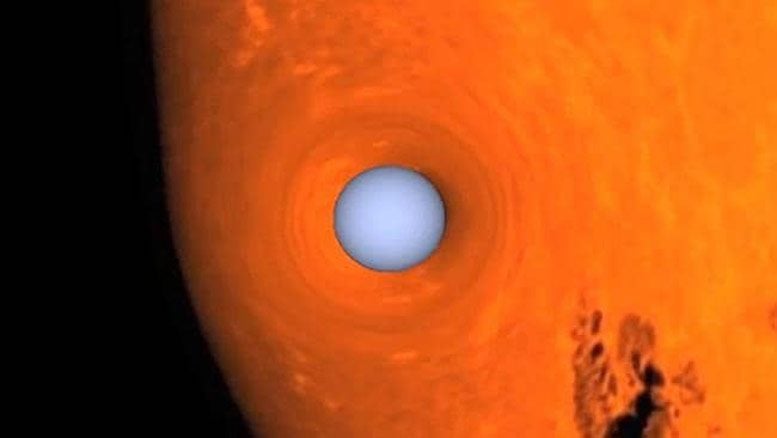
White dwarf orbiting another star source. Credit: Reused with permission, Eric Agol and NASA/SDO HMI science teams
A team of astronomers led by the Harvard-Smithsonian Center for Astrophysics have updated and confirmed self-lensing binary star KOI-3278’s companion to be a white dwarf star by pitting Einstein against Newton.
Discovered as the first self-lensing binary star system in 2014 by University of Washington scientists, KOI-3278’s behavior was originally reported as a result of microlensing based on periodic increases in brightness as the potential white dwarf companion passed in front of the G star and dips in brightness as it passed behind the star.
“We decided to pursue follow-up spectroscopy of the binary system with the goal of observing the orbital motion of the G star. With these new observations, we then created an independent Newtonian dynamical model of the system to confirm the companion as a white dwarf,” said Mr. Daniel Yahalomi, lead author of the paper. “This was a unique opportunity to independently apply Einsteinian and Newtonian gravitational theories to model the same binary system. We found a consistent set of predictions from these independent models, serving as another confirmation of these two gravitational theories.”
The Einsteinian model explains the periodic bending, or lensing, of the light paths from the G star due to the gravitational field of the foreground white dwarf, as described by Einstein’s theory of General Relativity. The Newtonian model explains the periodic Doppler shifts in the spectroscopic observations of the G star due to the gravitational pull of the white dwarf throughout its orbital motion, as described by Newton’s law of Universal Gravitation.
Self-lensing star system: The effects of gravitational lensing from a passage of a white dwarf star, simulated on an image of the Sun. Credit: Reused with permission, Eric Agol and NASA/SDO HMI science teams
The team took advantage of two independent campaigns to obtain and analyze spectra for the companion star using the High Resolution Echelle Spectrometer (HIRES) on the Keck I at Mauna Kea, and the Tillinghast Reflector Echelle Spectrograph (TRES) on the Tillinghast Reflector at the Fred Lawrence Whipple Observatory on Mount Hopkins in Arizona. The independent measurements yielded a difference in mass of just 5.2-percent, which is within the range of measurement uncertainty.
“Because the two independent approaches gave consistent results for the mass of the unseen companion, we gained confidence that although very different, both theoretical approaches are successful in explaining different aspects of gravity,” said Dr. David Latham, Senior Astronomer at the CfA | Harvard & Smithsonian, and an author on the paper. “Opportunities to make direct determinations of white dwarf masses are rare, so this result for KOI-3278 is a valuable asset as we test theoretical models for other white dwarf stars.”
For scientists, determining the model independent mass of a white dwarf allows for the anchoring of stellar evolutionary models. “These models describe the mass of stars at the end stages of their evolution,” said Yahalomi. “By combining two observational techniques with two different gravitational theories we were able to remove all assumptions and models about white dwarfs, and determine the mass of the white dwarf. By doing so, we then can test the existing white dwarf models.”
With these findings in hand, the team is busy working on follow-up observations of transiting planet candidates identified by the TESS mission, and searching for additional self-lensing binaries.
“We are hopeful that the TESS mission may provide evidence for other types of self-lensing binaries,” said Yahalomi. “Now that we know a joint Einsteinian-Newtonian model can help us to predict the properties of white dwarfs, we can test it on other self-lensing binaries. It’s a great example of how basic science helps us to understand how nature, and our universe, work and we are eager to see what happens next.”
Reference: “The Mass of the White Dwarf Companion in the Self-lensing Binary KOI-3278: Einstein versus Newton” by Daniel A. Yahalomi, Yossi Shvartzvald, Eric Agol, Avi Shporer, David W. Latham, Ethan Kruse, John M. Brewer, Lars A. Buchhave, Benjamin J. Fulton, Andrew W. Howard, Howard Isaacson, Erik A. Petigura and Samuel N. Quinn1, 22 July 2019, The Astrophysical Journal.
DOI: 10.3847/1538-4357/ab2649

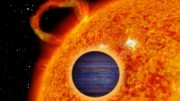
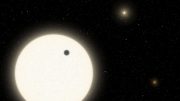
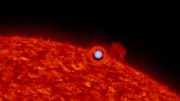
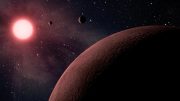
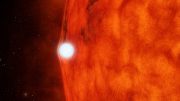
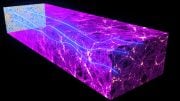
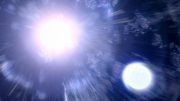
The Newtonian theory gives answers that are equivalent to the limit of General Relativity (the Einstein theory) in the case of weak gravitational fields, where space is not curved very much by the amount of mass in the vicinity. General Relativity gives the right answer in all known situations, while Newtonian gravity gives good approximate answers in many situations.
Hello Amy. I am finding the obmission of some important facts interesting and frustrating, when it comes tho the observation of any distant binaries, and more importantly, planets in nearby solar systems. Maybe you can agree, and possible relay to any of your colleagues to be addresed to the generally intereted public?
As I understand astronomical observations, they are direct, orbits around other distant bodies. It doesn’t take a astrophysicist to realize that this particular orbital plane is unique to our relative observational relationship to what we are observing. And given that, what speculated percentage of what we are observing is what actually exists on other orbital planes? Not just perpendicular to our perception, but fractions thereof, which would not reflect or be represented by changes of the other heavenly body that we are truly focusing in on? I could only fathom that a fraction of a percent of orbiting bodies are linear to our perspective, enough to influence our observations of the target body. Please take a brief moment to elaborate why this information is not forthcoming. We seem so exhilirated with our discoveries . . . are we neglecting to admit that there is the significant potential for so much more, and closer to our proximity?
If my comments are posted, may I clarify my frustrations in very simple terms. Take Saturn for an example. We can see it’s rings because this body is s close, we can make visual observations. If seen on edge, we can barely make any conclusion as to the extent of the rings, or that they actually exist. The opposite is true for distant planets outside of our solar system, or even more distant binary star systems, where we are observing the target for changes by another body, looking at the event on “edge”, or linear to our position. If the body were orbiting at most other inclinations (angles), the target body would have little change in it’s image (spectrometry), and thus we would assume? that nothing is orbiting?